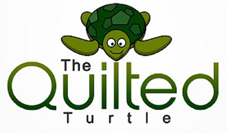When I decided to try Big Stitch Quilting, on of my first questions was “What types of threads should I use?”
The first thing to know when choosing thread is Big Stitch Quilting is meant to be seen. The stitches are large. Using contrasting thread gives a very prominent folk-art feel to your quilt. I love to mix lots of different colors in lots of different shades on my quilt.
The first thread I tried was perle cotton. The reason I started with perle cotton was because I had a big one-gallon zip lock bag full of perle cotton. I thought, “Wouldn’t it be great if I could use this up?” The perle cotton was a size 5. What I found is I could use this size of perle cotton, but the size meant that sometimes it was difficult to pull through the fabric layers.
Next I tried the next size smaller, #8. This is a good size to use on most cotton fabrics. It is small enough to pull through, and yet large enough to be seen and add color and interest to your quilt.
But I didn’t stop there. I also had lots of embroidery floss. I have always loved hand embroidery. In fact, that’s one reason I really love Big Stitch Quilting. I get to use some of those flosses I have on hand. Most of my floss is six-strand embroidery floss. I tried using all six strands and found, again, while I could use it, sometimes it was tough to pull through the layers. I now prefer to use 3 or 4 strands. If I use 3 strands, that means I can separate each piece I cut into two even groups of 3 strands each and won’t waste any thread. Three strands gives me enough thickness to see the color and see my stitches.
But still I wanted to try every type of thread I had on hand. One that was surprising was a multi-strand metallic silver thread. I don’t know where I got it or when, but there it was in my stash. I figured, if it didn’t work, it would be easy to take out the large stitches and start over. To my surprise, the metallic thread worked well. I put it into one of my scrap quilts. After much use, those metalic threads are holding up just as well as the cotton thread. If you use metallic thread, you will want to use a thickness that will easily pull through the layers. The one I used was made of several strands. I was able to use three strands at a time with success.
Fabric Choices
The types of threads that will work for your quilt will depend upon the type of fabric you use in your quilt. For instance, batik fabrics have a tight weave and can be difficult to pull the larger threads through. For batiks, I choose a smaller size perle cotton or 2 or three strands of embroidery floss. This makes a small diameter thread that I am pulling through the fabric.
For some loose-weave cottons, I am able to use the larger perle cottons and the full six strands of embroidery floss with no problem. My advice is to test your thread. Try quilting one length of thread and see how it goes. If it’s difficult to use, move to a smaller thread. The good news is Big Stitch is easy to take out so if you change your mind, you can easily pull out the test thread and begin again.
If you enjoyed this article, you might also like my YouTube video How To Hand Quilt Using Big Stitch Quilting.
Is your shop or guild looking for a good Big Stitch Quilting Workshop? I teach “Big Stitch Quilting – Fast, Easy and Inexpensive Way to Finish Your Quilt”. See my lectures and workshops page for details.



